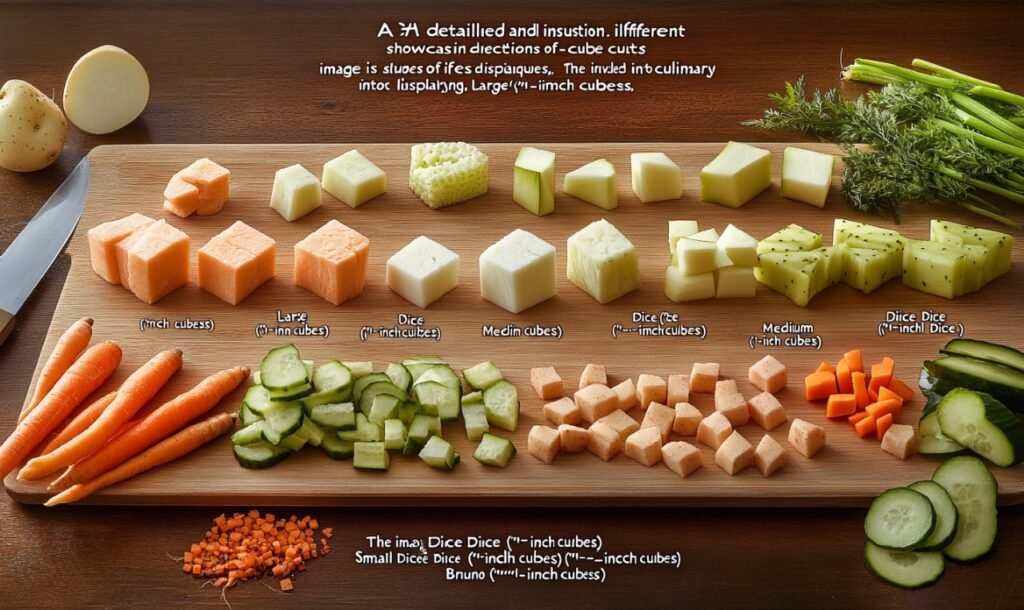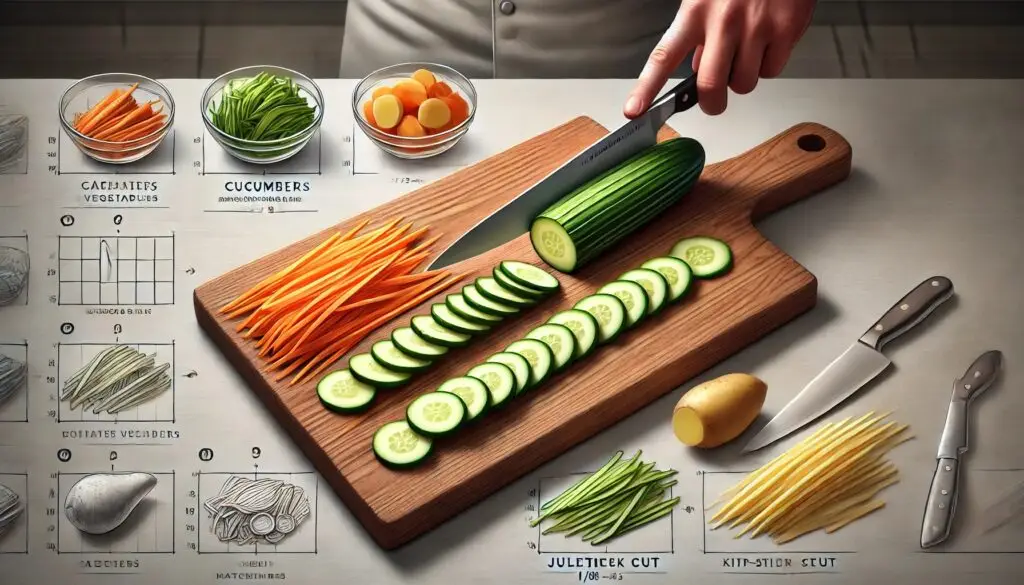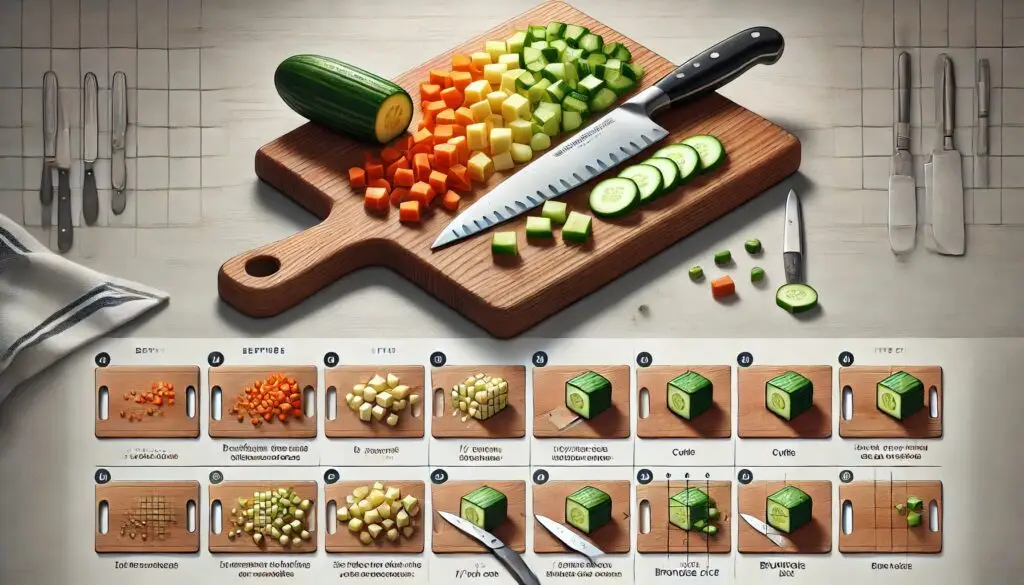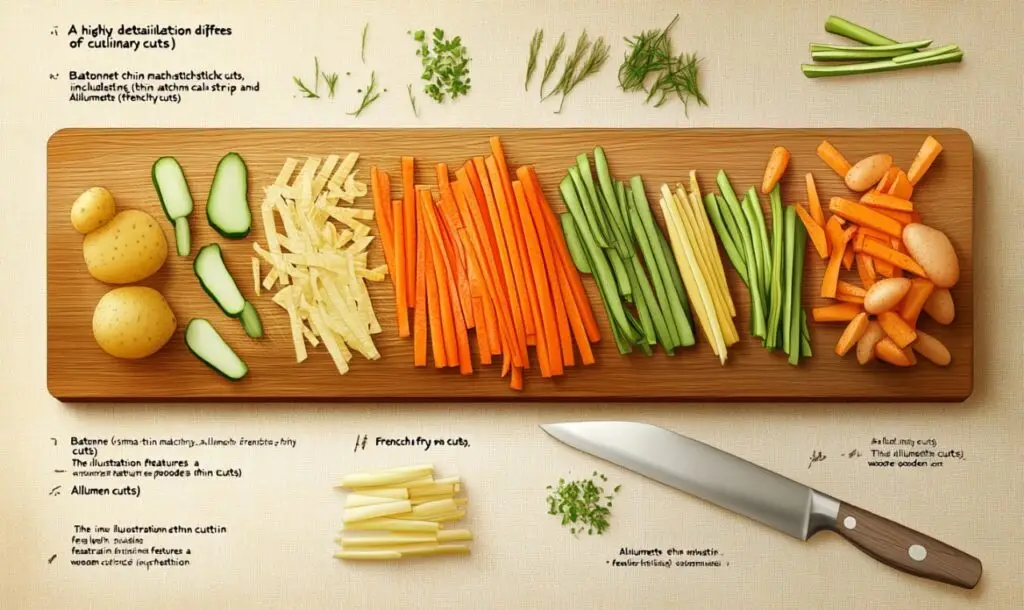
Introduction
Have you ever watched a professional chef effortlessly transform vegetables into works of art?
Their secret is in cheffy knife skills (and knives) for precision cuts. These techniques create even, bite-sized pieces. They are perfect for many cooking uses.
Mastering these cuts may seem daunting at first, but fear not! This comprehensive guide will equip you with the knowledge and knife skills to conquer French vegetable (precision) cuts and elevate your home cooking to new heights.
What are French Precision Cuts?
French precision cuts, also known as classical French cuts, are a collection of standardized methods for chopping vegetables into specific shapes and sizes. These cuts prioritize uniformity, not only for aesthetic appeal but also for even cooking and consistent textures in a dish.

Importance in Culinary Arts
French precision cuts are fundamental building blocks in culinary arts. They offer a multitude of benefits
-
- Even Cooking: Uniformly sized vegetables cook at the same rate, ensuring a perfect texture throughout your dish
-
- Flavor and Texture: Precise cuts enhance the way ingredients interact with each other, creating a more balanced and harmonious flavor profile.
-
- Visual Appeal: Beautifully cut vegetables add a touch of elegance and professionalism to any dish.
-
- Efficiency: Mastering these cuts allows you to work faster and more efficiently in the kitchen.
-
- Versatility: Many French cuts can be interchanged in recipes, allowing for creative freedom and improvisation.
Essential French Vegetable Cuts
Now that you understand the significance of French precision cuts, let’s delve into some of the most essential techniques:
Strip Cut
-
- Batonnet: Long, thin sticks resembling matchsticks, typically used for potatoes (frites), carrots (julienne fries), and celery. To achieve a batonnet, start by cutting the vegetable into batons (thick sticks), then slice the batons lengthwise into matchsticks.
-
- Julienne: Similar to batonnet but even thinner, resembling fine straws. Julienne cuts are perfect for vegetables like carrots, zucchini, and bell peppers for salads, stir-fries, and garnishes. Follow the same method as batonnet, but slice the batons into even thinner strips.
-
- Chiffonade: Thin ribbons of leafy green vegetables or herbs. To create a chiffonade, stack your leaves on top of each other, roll them tightly into a cigar shape, and finally slice the roll into thin ribbons. Chiffonade is ideal for adding delicate flavor and texture to salads, soups, and sauces.

Learn to Cook with Confidence!
Download Our App for Step-by-Step Lessons and Pro Tips!
Cube Cuts
-
- Macedoine: Tiny cubes, about the size of a matchstick head, perfect for garnishes, soups, and adding diced vegetables to salads. To achieve macedoine, first cut the vegetable into batons, then cube the batons into uniform pieces.
-
- Brunoise: Even smaller than macedoine, resembling fine dice, ideal for sauces, soups, and bases like mirepoix (a mixture of finely diced onions, carrots, and celery). The process is similar to macedoine, but with even smaller dices.

Precision Vegetable Cutting Techniques
Knife Skills for French Cuisine
To master French cuts, you need to learn techniques and improve your knife skills.
Here are some key points to remember
-
-
-
- Sharp Knife: A sharp knife is essential for clean, precise cuts. Invest in a good quality chef’s knife and keep it properly sharpened.
-
-
-
-
-
- Cutting Board: Use a stable cutting board that won’t slip while you work.
-
-
-
-
-
- Hand Position: Hold the knife firmly with your dominant hand, using your other hand to secure the vegetable and guide the blade.
-
-
-
-
-
- Posture: Maintain good posture with your feet shoulder-width apart and your back straight to avoid fatigue and injury.
-
-
Importance of Uniformity and Precision
While speed may come with practice, prioritize precision over speed when learning these cuts. Uniformly sized pieces ensure even cooking and create a visually appealing dish. Don’t be discouraged if your precision cuts aren’t perfect at first; consistency comes with practice.
Mise en Place: Preparing for Success
“Mise en place” (pronounced mee-zuh en plahs), a French term meaning “putting in place,” refers to the essential practice of prepping all your ingredients before you begin cooking. This includes washing, peeling, and cutting your vegetables according to the required cuts. Mise en place helps streamline the cooking process and reduces stress in the kitchen.
Organizing Your Workspace:
Set up your workspace efficiently. Have all your ingredients washed, peeled, and within easy reach.
Choosing the Right Tools:
Use the appropriate knife for the task at hand.

Step-by-Step Vegetable Cutting Guide
Let’s break down a few essential French cuts with step-by-step instructions:
Mastering Julienne
Prepare the Vegetable: Start by thoroughly washing the vegetable you have chosen, such as a carrot, under running water to remove any dirt or impurities. Once it is clean, proceed to peel the outer skin of the vegetable using a vegetable peeler, taking care to remove only the skin while retaining as much of the inner flesh as possible.
Cut into Batons: Next, take the peeled vegetable and place it on a cutting board. With a sharp knife, slice the vegetable lengthwise into long, thick sticks, which are commonly referred to as batons. Aim for a uniform thickness to ensure even cooking and presentation.
Create Julienne: Now, take the batons you have cut and carefully slice them again lengthwise, this time making much thinner cuts. These should resemble matchstick-like strips, which are often referred to as julienne cuts. This technique creates a delicate and visually appealing presentation for your dish.

Perfecting Brunoise
Prepare the Vegetable: Begin by thoroughly washing the vegetable, such as an onion, under running water to remove any dirt or impurities. After washing, carefully peel off the outer layer of the onion using a knife, making sure to remove all of the skin to get to the clean, edible part of the vegetable beneath. It is important to take your time in this step to ensure that the vegetable is clean and ready for cooking.
Cut into Batons: Once the vegetable is properly prepared, proceed to slice it lengthwise. Carefully cut the vegetable into long, thick sticks, commonly referred to as batons. The size and thickness of these batons can vary depending on your preference, but they should be uniform to ensure even cooking. This step is crucial, as the shape of the cut can affect the texture and cooking time of the vegetable.
Cut into Cubes: After you have created your batons, it is time to transform them into cubes. For this, take each baton and slice it crosswise into equal pieces, resulting in cube-shaped chunks of the vegetable. Ensuring that the pieces are uniformly sized will help them cook evenly and allow for a better presentation in your dish.
Create Brunoise: Finally, to create a brunoise, take the cubes that you have just cut and dice them into very small, uniform pieces. This means cutting the cubes into tiny squares, typically around 1/8 inch in size or smaller. Achieving this precise size will enhance the dish’s appearance and flavor, as the small pieces will cook quickly and distribute evenly throughout your meal

Creating Chiffonade
-
-
-
- Stack the Leaves: Begin by taking the leaves of your chosen herb or leafy green, such as basil or spinach, and carefully place them on top of one another. Make sure to align them neatly so that they form a uniform stack. This will help ensure even cutting later on.
-
-
-
-
-
- Roll Tightly: Once your leaves are stacked together properly, gently but firmly roll them up into a tight cylinder, resembling the shape of a cigar. It is important to maintain a consistent pressure while rolling to ensure the leaves stay compact.
-
-
-
-
-
- Slice into Ribbons: After you have successfully rolled up the leaves, take a sharp knife and slice the roll across its width into thin strips or ribbons. Aim for a consistent thickness to achieve even ribbons that will enhance the presentation and texture of your dish. A great test of knife skills!
-
-

Persevere and excel!
Mastering French precision cuts may require some practice and patience, but the rewards are well worth the effort. These techniques will enhance your culinary skills, elevate your dishes, and open up a world of culinary possibilities.
Benefits of Mastering French Precision Cuts
-
-
-
- Increased Confidence: As you gain proficiency in these cuts, your confidence in the kitchen will soar.
-
-
-
-
-
- Improved Cooking: You’ll be able to cook more efficiently and create more refined dishes.
-
-
-
-
-
- Creative Expression: French cuts provide a foundation for culinary creativity and experimentation.
-
-
Encouragement for Practice
Don’t be discouraged if your first attempts at precision cuts aren’t perfect. Practice makes perfect! Start with simple vegetables like carrots and onions, and gradually challenge yourself with more complex cuts. Watch videos, refer to images, and don’t hesitate to experiment.
If you spend time and effort learning these basic knife skills, you will improve your cooking.

Learn to Cook with Confidence!
Download Our App for Step-by-Step Lessons and Pro Tips!







